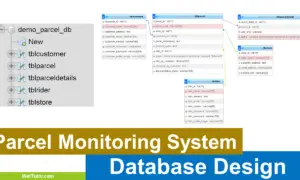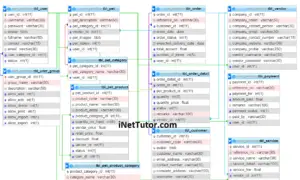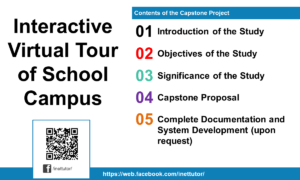Customer Satisfaction Survey App Related Literature
REVIEW OF RELATED LITERATURE
This chapter review different related literature on Customer Satisfaction Survey Application with reference to services and present various studies made regarding the issues related with manual Customer Satisfaction Survey.
Foreign Concept
Measuring Customer Satisfaction in Higher Education
According to the website Aldridge & Rowley (2006) states that, the students of Edge Hill University College use a questionnaire‐based survey to collect information on student satisfaction. Student responses were collected electronically through on‐screen questionnaires accessible over an intranet. Outcomes suggest that there remains some resistance to the completion of an electronic questionnaire and both paper and electronic versions are likely to continue to be necessary in order to achieve optimum response rates. These aspects have been further explored with focus groups and fed into the quality plan for the college.
Student Satisfaction of Online Courses for Educational Leadership
According to the website Sampson et al., (2010) states that, the study explored the students’ satisfaction of course components: instruction, communication, assessment, leadership, teamwork, professionalism, and respect / diversity. The findings on the first cohort survey with a hybrid format of course delivery, the 2005 baseline, showed a positive satisfaction with overall means between 3.79 and 4.48 on a five point Likert-scale with a 5 meaning strong agreement with satisfaction.

University faculty is asked to develop online courses as a response to the growing demands of students for increased access and flexibility of online courses. Further, faculty is encouraged to use the online format to increase the number of students in the programs. As university faculty are encourage to increase this growth of programs and students want the convenience of online courses, there is still a need to keep online courses rigorous with high quality instruction that is aligned with standards for educational leadership. There is a need for course evaluations of online courses and student satisfaction with those courses. Faculty responsible for the development and design of online educational leadership courses should assess their students’ satisfaction with the courses as part of the program evaluation. Student satisfaction and evaluation of online courses could result in increased quality of educational leadership programs and consequently increased student enrolment in the programs. This study verified that students are strongly satisfied with the components of quality online courses in an educational leadership department at one university.
Examining student satisfaction with higher education services: Using a new measurement tool
According to the website Gruber et al., (2010) states that, the study gave a valuable insight into how students perceive the quality of the services offered at a university and how satisfied they are with these offerings. The results show that students’ satisfaction with their university is based on a relatively stable person‐environment relationship. Thus, the satisfaction of students seems to reflect quite well perceived quality differences of offered services and of the wider environment. Students were particularly satisfied with the school placements and the atmosphere among students. Students were mostly dissatisfied with the university buildings and the quality of the lecture theatres.
Collecting Customer Satisfaction Data with Web Surveys
According to the website (De Gruyter, 2011) states that, measuring customer satisfaction is a very important aspect of marketing strategy. For the organization’s survival in the long run it is indisputable to have the ability to retain the customers. Retaining customers is more profitable than attracting new ones because it is easier to sell a product or service to someone who has already used it, rather than someone to whom is product or service completely unknown. In order to measure customer satisfaction primary data’s were collected using a test method on a sample of students, by a questionnaire in a physical form, analyzing the basic elements of educational process. Also, by researching relevant national and international professional and scientific literature the test method was described, and all of its models. Finally, in the conclusion, the basic thoughts about the paper are revealed through the presentation of practical advantages and disadvantages of marketing concept of satisfaction, and reviewing recent trends in communication with students.
Self-Concept, School Satisfaction, and Other Selected Correlates of Subjective Well-Being for Advanced High School Learners Enrolled in Two Challenging Academic Settings
According to the website Robertson (2015) states that, Global self-concept, freedom from anxiety, happiness, popularity, and school satisfaction were examined for 224 partial-day Governor’s School students attending public Governor’s Schools as well as classes in their home high schools, and 56 students taking advanced classes in regular high schools. On average, self-concept appeared adequate to strong, and the two groups were similar in self-esteem. However, in the regular school setting, academic self-perception was stronger for the Governor’s School group. On average, females in the total sample had lower freedom from anxiety scores than the males, and more expressed frequent worry than a comparison standardization group. The Governor’s School students expressed more positive attitudes toward the Governor’s Schools than toward their home high schools, although their academic self-perception was lower in the Governor’s Schools than in their home schools. They also, on average, were more satisfied with the Governor’s Schools than the regular high school advanced students were with their schools.
Local Concepts
Library Evaluation and Performance Measurement: A Review of Literature
According to Fe Angela M. Verzosa, (Verzosa, nd, para. 1-3). Evaluation of library services should be regarded as a management tool, applied to determine how effectively and efficiently the library is serving the needs of its users, to identify the limitations and failures of service, and to recommend ways to improve such service. The extent to which the user’s needs are satisfied depends on the size and collection of the library, the adequacy and accuracy of the organization of its materials.
Some aspects of library service are more easily evaluated than others. Generally, the more concrete or specific the user requirement is, the easier it is to measure user satisfaction in absolute terms. The extent to which the library is used reflects the degree of user satisfaction, which may be measured by subjective procedures such as questionnaires or interviews, or by more objective, quantitative measures, such as percentage calculations and determination of capability indexes, etc.
The search for good ways of measuring the quality of service (measuring techniques) must, however, start with defining the characteristics of a “good library,” what characteristics are important to measure, and whether the statistics to be derived from the measurement will be useful and relevant to the determination of the library’s effectiveness or ineffectiveness.
Customer Satisfaction Survey 2011
Eight of every Ten Clients are satisfied with the way NSO delivers its Services
Fetch from (www.web0.psa.gov). The 2010 Survey of Information and Communication Technology (SICT) was conducted in 2011 primarily to collect and generate information on the access and utilization of ICT among establishments in the country for reference year 2010. The SICT adopted the Information Economy as its framework.
According to the website of National Statistic Office (Customer Satisfaction Survey, 2011, para. 1 to 3). The results of December 2011 customer satisfaction survey round showed further improvement of 0.5 percentage point in the overall proportion of satisfied clients. About eight of every ten clients (78.6 percent) felt satisfied with the way NSO delivers its services to the public. A quarter ago, in September 2011, the satisfaction rating stood at 78.1 percent. In the same period last year (December 2010), this figure was observed at 81.9 percent. Satisfaction rating is measured as the percentage of clients surveyed during the reference period who were either satisfied or very satisfied with NSO’s civil registry services.
The net satisfaction rating showed a slim 0.2 percentage point improvement to +76.4 percent in December 2011 from +76.2 percent net satisfaction rating registered during the previous quarter. Net Satisfaction rating refers to the difference between the proportion of satisfied and dissatisfied clients.
A total of 738 thousand processed transactions in December 2011 were served all over the country. Of this number, about 34 percent or 253 thousand transactions were processed and released in Metro Manila service areas covered by the survey. These areas include the NSO Civil Registration Service Areas in East Avenue, Quezon City (Application, Releasing, Endorsement, Party Waiting, and Travel Agency areas) and the five (5) other Metro Manila Outlets (Makati, Caloocan, Muntinlupa, Pasig, and Pasay Census Serbilis Centers).
Customer Satisfaction on the Services Rendered by Montenegro Shipping Lines
According to the website of Montenegro Shipping Lines (Sunto et al., 2010, para. 1). The study aims to assess customer satisfaction on the services rendered byMontenegro Shipping Lines. More specifically to know the profile of the respondents, customer satisfaction on the services rendered by Montenegro Lines in terms of Front Line, Housekeeping and Food and Beverage services, and to know the difference in responses when respondents were grouped according to profile variables. Descriptive method was utilized in the study. Findings revealed that customers are satisfied on the services rendered by Montenegro Shipping Lines. The level of customer satisfaction rendered by Montenegro Lines does not differ when grouped based on their profile. The study recommended that the management may conduct Values Enhancement Seminar for the employees. Additional trainings should be conducted to improve the employees’ skills and competence. They must improve room amenities and services. The management may present options/choices in terms of food. Future researches may conduct similar study using other variables.
National Statistic stated these facts, too. Customer Satisfaction is top priority of Montenegro Shipping Lines, Inc. a domestic shipping company established on September 16, 1978 by Vicente Leyco Montenegro, Sr.who was the pioneer service provider of commercial and public transportation by sea via theroute Batangas City – Abra deIlog and back.
As a Cruise Line Operation in Hotel services students, the researchers choose toassess customer satisfaction atMontenegro Shipping Lines. The level of customersatisfaction is an indication profitability and stability. This is our way of knowing our prospects and opportunities after graduation. This is also one way of helping them to improvethe services of Montenegro Lines as future professionals in the hospitality industry.
Related Studies
Customer satisfaction in E-Commerce: a case study of China and Bangladesh
According to the website (Rahman &Han, 2011). This research is intended to study consumer satisfaction using e-commerce. They Analyze and summarize the specific elements of ecommerce customer satisfaction, and the various elements of their expectations and perception. Their main object has been to apply the ideas of two factor theory on an empirical context. It will present detailed idea about how the research will be conducted and which methods and techniques will be implemented for conducting the research. Through customer satisfaction survey, enterprises can grasp the reasons for customer satisfaction or Dissatisfaction; customers can analyze the implied forecast of potential demand, thus promoting the enterprises products and services, continuous improvement and innovation.
Measuring Customer Satisfaction for Various Services Using Multi-criteria Analysis
Fetch from the website of (www.unipi.gr), this paper is to present original customer satisfaction evaluation projects in different business organizations from the public and the private sector. The objectives of the customer satisfaction surveys are focused on the assessment of the critical satisfaction dimensions, by means of qualitative questions, and the determination of customer groups with distinctive preferences and expectations.
The methodological approach is based on the principles of multi-criteria modelling, while the preference disaggregation MUSA (Multi-criteria Satisfaction Analysis) method is used for data analysis and interpretation.
Customer Satisfaction and Multi-Criteria Analysis
Although, extensive research has defined several alternative approaches for the customer satisfaction evaluation problem, all these proposed models and techniques, so far, adopt the following main principles (Grigoroudis, 1999):
- a) The data of the problem are based on the customers’ judgments and should be directly collected from them.
- b) Customer satisfaction measurement is a multivariate evaluation problem given that customer’s global satisfaction depends on a set of variables representing service characteristic dimensions.
- c) Usually, an additive formula is used in order to aggregate partial evaluations in a global satisfaction measure.
Based on these assumptions the customer satisfaction evaluation problem can be formulated in the context of multi-criteria analysis, assuming that client’s global satisfaction depends on a set of criteria or variables service characteristic dimensions.
Prior Art
As we proposed this system Satisfaction Survey, a system for school that will be using Tablet for its users, yet there’s an existing system like into business.
According to the website Hemanth CRPatna (Customer Satisfaction, 2015, para. 1 to 3). Customer satisfaction is related to the human activity directed at satisfying human wants through the exchange of goods and service.
Satisfying the customers occupies a most important position in business management. Customer satisfaction plays a crucial and critical role as it deals with customers and their needs. The major task of organization is to satisfy customers by meeting their needs and wants.
The essence of organization is the customer and not the product shall be the heart of the entire business system. It emphasizes on customer oriented business. Policies and programs, which are formulated to serve efficiently the customer demand. Satisfaction of a customer is so basic that it cannot be considered as a separate function. It is the way whole business seen from the point of view of its final results i.e., from the customer point of view.
Synthesis
Related literature, foreign and local concept and prior art provides a worthy basis with the proposed system Customer Satisfaction Survey Application. There were a lot of related studies that had been discussed and cited related with our studies, and in comparison with our study and to those related data that being gathered is informational similar.
Related literature, foreign and local concept and prior art has proven that the proposed system has a lot and need to be improved for the success of making this study implemented.


